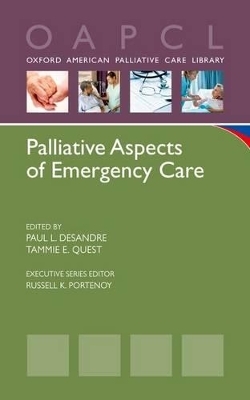
Palliative Aspects of Emergency Care
Oxford University Press Inc (Verlag)
978-0-19-989561-8 (ISBN)
The process of patients with advanced illnesses entering the emergency department is fraught with uncertainty for both patients and medical providers. Yet, there is a lack of definitive and accessible resources which provide immediate guidance for the care of these patients. Palliative Care in the Emergency Care is a practical guide designed to fill this void. From the paramedic struggling with difficult and/or conflicting information in the home through the palliative care specialist trying to interface effectively with the emergency department, this user-friendly handbook offers practical help from experts in the interdependent fields of Emergency Medicine and Hospice and Palliative Medicine. This evidenced-based book covers the prognostication and assessment of relevant, advanced-illness clinical problems, the management of symptoms, and the physical and spiritual treatment of palliative patients in the emergency department through their last hours of living. Also included are chapters focusing on hospice care, communication techniques, and the legal and ethical issues of palliative care in the emergency department. This guide is a must-have resource for clinicians looking for concise, point-of-care information, and for hospital administrators working to address palliative care needs in emergency departments through best practice recommendations.
Assistant Professor, Department of Emergency Medicine and Center for Palliative Care; Associate Fellowship Director, Hospice and Palliative Medicine, Emory University School of Medicine, Atlanta, Georgia
Chapter 1: Overview ; Chapter 2: Trajectories and Prognostication in Emergency Care ; * Emergency Department and Functional Trajectories ; * Prognostication and Prognostic Tools ; o Cancer ; o Heart Failure ; o Chronic Obstructive Pulmonary Disease ; o Dementia ; * Communicating the Prognosis ; * Creating a Plan of Action ; Chapter 3: Rapid Palliative Care Assessment ; * The Critically Ill or Unstable Patient ; * The Medically Stable Patient ; Chapter 4: Cancer Emergencies ; * Spinal Cord Compression ; o Pathophysiology ; o Epidemiology ; o Signs and Symptoms ; o Diagnosis ; o Interventions ; Corticosteroids ; Radiation Therapy ; Surgery ; Bisphosphonates ; * Superior Vena Cava Syndrome ; o Pathophysiology ; o Etiology ; o Signs and Symptoms ; o Diagnosis ; o Interventions ; Radiation Therapy and Chemotherapy ; Endovascular Stenting ; o Prognosis ; * Hypercalcemia of Malignancy ; o Pathophysiology ; o Interventions ; Chapter 5: Malignant Pain ; * The Cancer Pain Emergency ; * The Emergent Pain Assessment ; o Pain scales ; o Classification ; o Opioid naive and opioid tolerant ; * Pharmacologic Management ; o Choosing an Algorithm ; o Using Equianalgesic dosing tables ; o Calculating the Initial Dose of an Opioid ; o Advanced Age, Renal Impairment, and Hepatic Impairment ; o Routes of Administration and Pharmacokinetics ; o Pain Reassessment after Treatment ; o Opioid Side Effects and Toxicities ; Sedation and Respiratory Depression ; Nausea and Vomiting ; Myoclonus ; Constipation ; * Confrontation of Barriers ; * Methadone ; * Non-Opioid Pharmacologic Management ; o Neuropathic Pain ; o Bone Pain ; o Other Approaches ; Chapter 6: Non-malignant Pain ; * Pain Pathophysiology ; * Physiologic and Clinical Differences between Acute and Chronic Pain ; * Definitions ; o Tolerance ; o Physical dependence ; o Addiction ; o Pseudoaddiction ; * General Principles for Managing Chronic Pain ; * Policies Informing Emergency Department Management of Chronic Pain ; * An Emergency Department Approach to Managing Chronic Pain ; Chapter 7: Symptom Management ; * Dyspnea ; o Pharmacologic approaches ; Oxygen ; Opioids ; Anxiolytics ; o Complementary and Non-Pharmacologic Approaches ; * Delirium ; * Anxiety ; * Fatigue and Weakness ; * Insomnia ; * Fluid Balance and Edema ; * Nausea and Vomiting ; * Constipation ; * Diarrhea ; Chapter 8: Spiritual Suffering and Bereavement ; * Definitions ; * Grief: Normal and Complicated ; * Spiritual Needs in the Emergency Department ; o Role of the Clinician ; o Role of the Chaplain ; * Rapid Spiritual Assessment ; * Responding to Hoping for a Miracle. ; Chapter 9: Communication ; * Breaking Bad News ; * Death Disclosure ; * Special Considerations ; o Culture ; o Requests to Withhold Information ; o Telephone Notification ; o No Next of Kin Available ; o Communicating with Children ; * Death of a Child ; o Sudden Infant Death Syndrome ; o Miscarriage or Stillbirth ; * Self-Care and the Care of Other Emergency Department Staff ; Chapter 10: Resuscitation, Family Presence, and Last Hours of Living ; * Cardiopulmonary Resuscitation and Prognosis in Advanced Illness ; * Family Presence During Resuscitation ; * Witholding or Withdrawing Interventions ; o CPR ; o Intubation and Artificial Ventilation ; o Artificial Nutrition and Hydration ; o Antibiotics ; * Care of the Actively Dying Patient ; o Environment ; o Symptom Control ; o Secretions ; o Dry Mouth ; o Agitation ; o Opioid Toxicity ; Chapter 11: Hospice ; * Understanding Hospice Care ; o Eligibility ; o Underutilization ; o Scope of Services and Reimbursement ; o Discontinuing Hospice Care ; * Emergency Department Management of Patients under Hospice Care ; * Common Presentations ; * Initiating New Hospice Referrals from the Emergency Department ; Chapter 12: Legal and Ethical Issues of Palliative Care in the Emergency Department ; * The Interrelation of Law, Ethics, and End-of-Life Care ; * Informed Consent ; * Limitation of Treatment ; * Determination of Decision-Making Capacity ; * Decision-Making for the Incapacitated ; * DNR Orders and Physician Orders for Life-Sustaining Treatments ; * Opioids and End-of-Life Care ; * Suicide and Physician-Assisted Suicide ; * Futility
| Reihe/Serie | Oxford American Palliative Care Library |
|---|---|
| Verlagsort | New York |
| Sprache | englisch |
| Maße | 201 x 124 mm |
| Gewicht | 181 g |
| Themenwelt | Medizin / Pharmazie ► Medizinische Fachgebiete ► Notfallmedizin |
| Medizin / Pharmazie ► Medizinische Fachgebiete ► Palliativmedizin | |
| Medizin / Pharmazie ► Pflege ► Fachpflege | |
| ISBN-10 | 0-19-989561-9 / 0199895619 |
| ISBN-13 | 978-0-19-989561-8 / 9780199895618 |
| Zustand | Neuware |
| Informationen gemäß Produktsicherheitsverordnung (GPSR) | |
| Haben Sie eine Frage zum Produkt? |
aus dem Bereich


